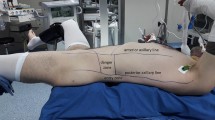Abstract
Our objective was to analyze the advantages of the percutaneous nephrolithotomy in oblique supine decubitus compared to the prone and dorsal supine position. In 87 patients diagnosed with urolithiasis (495.5–530.8 mm2), percutaneous nephrolithotomy (PNL) was performed from 2000 to 2011. The patients were divided into three groups: Group A, 32 patients, PNL in the prone decubitus position; Group B, 24 patients, PNL in the dorsal supine position; Group C, 31 patients, PNL in the oblique supine position. We analyzed intraoperative parameters, complications, and results among the three groups. The three procedures were performed with a single access, 24-30 Ch. No statistically significant differences were found among the three groups regarding the patients’ characteristics, or the morphology or size of the kidney stone treated. The operation time was shorter in the cases of PNL in dorsal supine and oblique supine compared to the prone position. The complication rate was very similar in the three groups. The main advantage of the PNL in oblique supine compared to the dorsal supine was that the puncture could in all cases be directed by ultrasonography, with greater precision, more safety, and more control of the percutaneous renal access. The oblique supine decubitus position is a safe position for the percutaneous treatment of urolithiasis and it becomes easier when the puncture is guided by ultrasound.


Similar content being viewed by others
References
Fernstrom I, Johansson B (1976) Percutaneous pyelolithotomy: a new extraction technique. Scand J Urol Nephrol 10:25–29
Ibarluzea Gonzalez G, Gamarra Quintanilla M, Gallego Sanchez JA, Pereira Arias JG, Camargo Ibargaray I, Bernuy Malfaz C (2001) Litotricia renal percutánea. Evolución, indicaciones y metodología actual en nuestra unidad de litotricia. Arch Esp Urol 54:951–969
Valdivia Uria JG, Valle Gerhold J, Lopez Lopez JA, Villaroya Rodríguez S, Ambroj Navarro C, Ramirez Fabian M et al (1988) Technique and complications of percutaneous nephroscopy: experience with 557 patients in the supine position. J Urol 160:1975–1978
Ibarluzea G, Scoffone CM, Cracco CM, Poggio M, Porpiglia F, Terrone C et al (2007) Supine Valdivia and modified lithotomy position for simultaneous anterograde and retrograde endourological access. BJU Int 100:233–236
Ng MT, Sun WH, Cheng CW, Chan ES (2004) Supine position is a safe and effective for percutaneous nephrolithotomy. J Endourol 18:469–473
Fernandez Gonzalez I, Santos Arrontes D, Llanes Gonzales L, Espinales Castro G, Lujan Galan M, Berenguer Sanchez A (2005) Tecnica e indicaciones de la nefrolitotomia percutánea “mini-percutanea”. Arch Esp Urol 58:55–60
Zilberman DE, Lipkin MED, de la Rosette JJ, Fernandino MN, Mamoulakis C, Laguna MP et al (2010) Tubeless percutaneous nephrolithotomy—the new standard of care? J Urol 184:1261–1266
Melchert E, De Farias JO Jr. (2010) Nueva técnica para realizar nefrolitotripsia percutánea “decúbito dorsal total”. Actas Urol Esp 34:726–729
Ray AA, Chung DG, Honey RJ (2009) Percutaneous nephrolithotomy in the prone and prone-flexed positions: anatomic considerations. J Endourol 23:1607–1614
Fernández Garcia A, Toledo Viera A, Carreño Rodríguez J, Gonzalez Martin R, Moreno Segismundo J, Fernandez Aportela O et al (2009) Nefrolitotomía percutánea en decúbito supino. Posicion de Valdivia. Arch Esp Urol 62:289–293
Amon Sesmero JH, Del Valle Gonzalez N, Conde Redondo C, Rodríguez Toves A, Cepeda Delgado M, Martinez Cegarra Oceja JM (2008) Comparacion entre la posición de Valdivia y la posición prona en la nefrolitectomía percutánea (NLP). Actas Urol Esp 32:424–429
De Sio M, Autorino R, Quarto G, Calabrò F, Damiano R, Giugliano F et al (2008) Modified supine versus prone position in percutaneous nephrolithotomy for renal stones treatable with a single percutaneous access: a prospective randomized trial. Eur Urol 54:196–203
Shoma AM, Eraky I, El-Kenawy MR, El-Kappany HA (2002) Percutaneous nephrolithotomy in the supine position: technical aspects and functional outcome compared with the prone technique. Urology 60:388–392
De la Rosette JJMCH, Tsakiris P, Ferrandino MN, Elsakka AM, Rioja J, Preminger GM (2008) Beyond prone position in percutaneous nephrolithotomy: a comprehensive review. Eur Urol 54:1262–1269
Skolarikos A, de la Rosette J (2008) Prevention and treatment of complications following percutaneous nephrolithotomy. Curr Opin Urol 18:229–234
Fariña Perez LA, Zungri Telo ER (2005) La posición supina de Valdivia como mejor opción para la cirugía percutánea de los cálculos renales en el paciente con obesidad mórbida. Actas Urol Esp 29:997–1000
Skolarikos A, Alivizatos G, de la Rosette JJMCH (2005) Percutaneous nephrolithotomy and its legacy. Eur Urol 47:22–28
Manohar MD, Prashant Jain MS, Mahesh Desai MS (2007) Supine percutaneous nephrolithotomy: effective approach to high-risk and morbidly patients. J Endourol 21:44–49
De la Rosette JJMCH, Laguna MP, Rassweiler JJ, Conort P (2008) Training in percutaneous nephrolithotomy—a critical review. Eur Urol 54:994–1003
Ko R, Soucy F, Denstedt JD, Razvi H (2008) Percutaneous nephrolithotomy made easier: a practical guide, tips and tricks. BJU Int 101:535–539
Conflict of interest
The authors declare that they have no conflict of interest.
Author information
Authors and Affiliations
Corresponding author
Rights and permissions
About this article
Cite this article
Arrabal-Martin, M., Arrabal-Polo, M.A., Lopez-Leon, V. et al. The oblique supine decubitus position: technical description and comparison of results with the prone decubitus and dorsal supine decubitus positions. Urol Res 40, 587–592 (2012). https://doi.org/10.1007/s00240-012-0471-5
Received:
Accepted:
Published:
Issue Date:
DOI: https://doi.org/10.1007/s00240-012-0471-5




